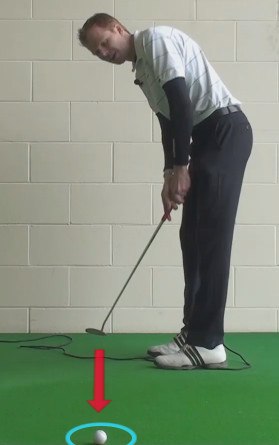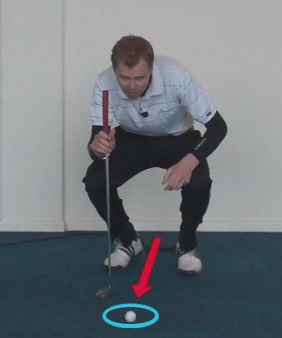
Make the Come back Putt
Many times during a round of golf, you will be in a position to have to make a comeback putt. Making these putts will help the mental side of your golf game and help lower your scores. Below is information to help in making sure that you get yourself in a good position to make the comeback putt.
Even before you stroke the initial putt on the green, make sure you make several observations about what lays in front of you. Does the green slope back to front (as many do)? Is the green slow or fast? Where would a good “leave” putt be? Good putting is a lot about observation and using it to your advantage.
If you are closer to the hole than your playing partners, you will have the chance to see how the ball is rolling. You’ll especially want to pay close attention as the ball nears the hole and if your partner is putting in your line. Standing above or below your players, line is the best. For etiquette’s sake, make sure you are not in their peripheral view.
After you’ve stroked your initial putt, and it goes past the hole, make sure you keep observing. This is crucial. You want to see how the putt is reacting as it passes the hole.
If you have a tester left, don’t get too upset. Stay confident and upbeat. Think that you will make it.

With the knowledge of how the putt broke past the hole and – perhaps – how others broke around the hole, get a good look from behind the line and around it. Take your time. Rushing oftentimes produces careless results.
Today, many professional golfers mark their balls with a straight line. You may use this to your advantage too. As you are setting your ball back into play on the putting green, line up the ball with the marking facing your target. Many times, the line of the putt changes as you get over the ball, so you’ll need to trust your mark.
Focus on the line of your putt. Take out as much of the break as you feel comfortable with doing by hitting the ball firmer. Many players fail to hit the ball and leave it short.
As you set-up over the ball, maintain your confidence and be sure of the line you want to putt the ball over. If you aren’t sure, back away and setup again. The more confident you are over the ball, the better your chances of making it.
Take the putter back and through using your shoulders and watch as your come backer drops!
Q: What is a “Come Back Putt” in golf? A: A “Come Back Putt” is a term used to describe a second putt that a golfer faces after missing the first putt and leaving the ball some distance away from the hole. It is the putt that a golfer attempts to make to complete the hole after the initial putt was not successful.
Q: How important is the Come Back Putt in a golfer's overall score? A: The Come Back Putt is essential in a golfer's overall score because it determines whether the golfer will make a one-putt or two-putt on the hole. Making the Come Back Putt ensures that the golfer does not waste strokes and saves valuable shots on the scorecard.
Q: What are some tips for successfully making the Come Back Putt? A: Some tips for successfully making the Come Back Putt include:
- Stay focused: Maintain your concentration on the putt and commit to your stroke.
- Read the green: Take time to read the break and slope to make an accurate putt.
- Speed control: Ensure that the pace of the putt is correct, giving it the best chance to drop in the hole.
- Follow through: Maintain a smooth and consistent follow-through to keep the ball on the intended line.
Q: How can golfers overcome the pressure of the Come Back Putt, especially in competitive situations? A: To overcome the pressure of the Come Back Putt, golfers can use pre-putt routines to calm nerves and focus on the process rather than the outcome. Deep breathing and positive self-talk can also help manage pressure and instill confidence.
Q: Are there any specific techniques for practicing Come Back Putts? A: Yes, golfers can practice Come Back Putts by setting up drills on the practice green. They can intentionally miss putts from various distances and practice making the subsequent Come Back Putt. This helps develop the skills and mindset required for successful comebacks during rounds.
Q: What is the best approach for golfers when faced with a long Come Back Putt? A: When faced with a long Come Back Putt, golfers should prioritize speed control and lagging the ball close to the hole. Reducing the risk of three-putting by leaving the ball close ensures they have a high percentage chance of holing the Come Back Putt.
Q: How do golfers deal with challenging greens when attempting a Come Back Putt? A: On challenging greens, golfers should assess the slopes and undulations before attempting the Come Back Putt. They should read the break carefully and consider the speed of the putt to give themselves the best chance of making it.
Q: Can Come Back Putts have a psychological impact on a golfer's confidence? A: Yes, Come Back Putts can have a psychological impact on a golfer's confidence. Successfully making Come Back Putts can boost confidence and create positive momentum, while missing them might lead to doubts and affect subsequent putts.
Q: Should golfers always try to make the Come Back Putt, or are there situations where it's better to play safe? A: Golfers should always try to make the Come Back Putt, as sinking the putt saves strokes on the scorecard. However, in some situations where the putt is long and challenging, playing safe and lagging the ball close might be a wise strategy to avoid three-putting.
Q: How can golfers assess their Come Back Putt statistics and identify areas for improvement? A: Golfers can assess their Come Back Putt statistics by keeping track of their putting performance during rounds. They can record the number of Come Back Putts made and missed and analyze patterns to identify areas for improvement. Keeping a putting log can be helpful in tracking progress over time.
Thomas Golf Putters
Traditional, Mid-Length/Belly & Long Putters






